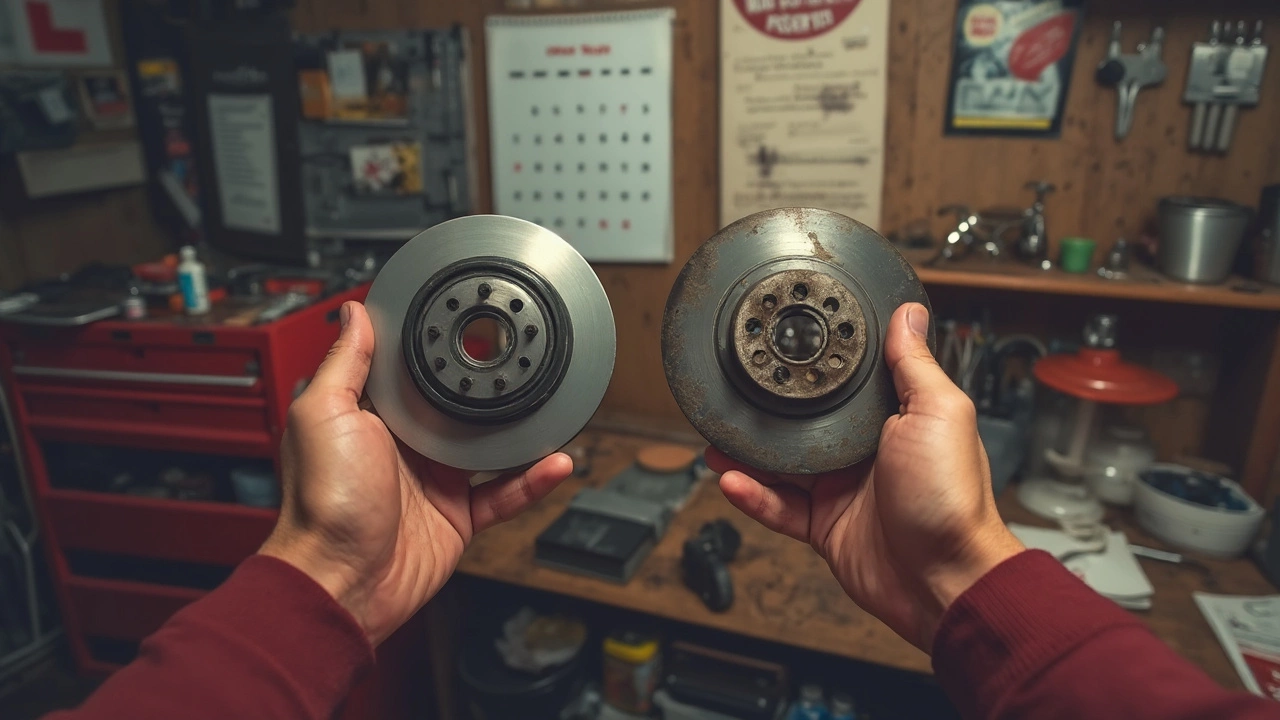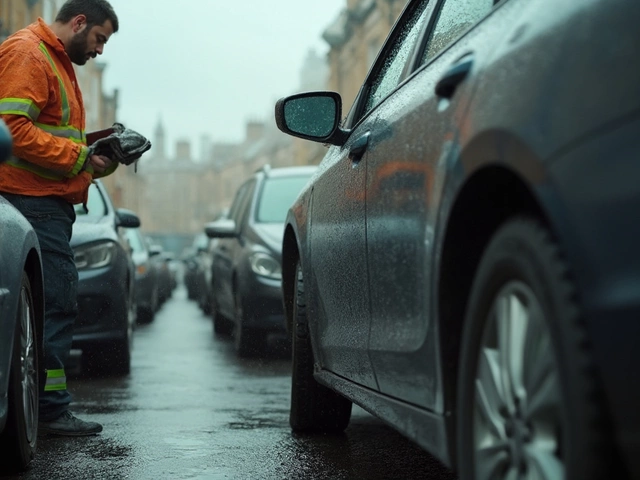Ever felt that sinking feeling when you hear the mechanic tell you it's time to replace your brake pads and rotors? It's one of those car maintenance tasks that nobody looks forward to, yet it's absolutely vital for safety. To keep the financial surprise to a minimum, it's important to have a rough idea of what costs should be.
The price you pay varies greatly based on your car make and model, but typically, expect to shell out between £150 and £400 per axle for brake pad and rotor replacement. Yes, that can add up quickly, especially if you drive a fancy luxury car. Wonder why?
Well, the type of parts plays a big role. Do you go for original manufacturer parts or aftermarket options that might be cheaper? Each has its pros and cons, from lifespan to performance, that we'll unpack as we delve deeper into the nitty-gritty of the costs involved.
- Understanding Brake Parts and Their Functions
- Factors Influencing Replacement Costs
- Cost Breakdown: Labor vs. Parts
- DIY Tips: Doing It Yourself
Understanding Brake Parts and Their Functions
Okay, so before we dive into costs and other details, let’s break down what we’re actually dealing with. Knowing the ins and outs of your car's brake pads and rotors can really help when it’s time to head to the mechanic or even tackle some basic maintenance yourself.
Brake Pads: The Unsung Heroes
First up, brake pads. They’re those small slabs inside your vehicle that press down on the rotors, creating friction and slowing you down. Made from materials like metallic or ceramic compounds, they’re tough but not immortal. Over time, they wear thin due to all that friction, and when you start hearing that telltale squeal, it’s time to think about replacements.
Rotors: The Solid Disc
Then you have your rotors, the round metallic discs that your pads clamp onto. As they absorb the heat and friction when the pads squeeze against them, they can also wear out. Warped rotors are a common issue and can lead to shaky braking, which is both annoying and unsafe.
The Symbiotic Relationship
Pads and rotors work together. In fact, changing them at the same time can improve longevity and performance. If new pads are gripping old, worn-out rotors, they won’t last as long and you’ll probably end up replacing them sooner than expected.
| Type | Average Lifespan (Miles) |
|---|---|
| Brake Pads | 30,000 - 70,000 |
| Rotors | 50,000 - 70,000 |
Keeping track of mileage can give you a clue about when to start planning replacements. Knowing what these parts do and looking for signals like squealing brakes or a vibrating steering wheel can prevent unexpected breakdowns. Now that we've got a handle on the components, we're set to tackle questions about costs and maintenance options later in the article.
Factors Influencing Replacement Costs
When replacing brake pads and rotors, the cost isn't just about the parts themselves—several factors can drive the price up or down. Understanding these can save you from unexpected expenses and help you make informed decisions.
1. Car Make and Model
The first biggie? The type of car you're driving. Own a top-tier luxury car or a rare vintage model? Replacement parts for these can cost more due to their unique specifications and limited availability. A modest family car, however, can often mean lower prices thanks to the wide availability of generic parts.
2. Quality of Parts
Do you opt for OEM (Original Equipment Manufacturer) parts or go for more budget-friendly aftermarket alternatives? OEM parts are typically pricier but offer a guarantee of quality and perfect compatibility. Aftermarket parts, while cheaper, can sometimes vary in terms of longevity and performance.
"While aftermarket parts can offer savings, always ensure they're from a reputable supplier. The wrong choice can mean more frequent replacements," advises renowned auto expert John R. Tunner in Car Driver Magazine.
3. Labor Costs
Labor can take a considerable chunk of your expenses. Rates fluctuate widely depending on the mechanic you choose. Dealerships charge more, often justified by their brand know-how and reliability. Independent garages usually offer better rates, but their service quality can be hit or miss.
4. Geographic Location
Where you live impacts costs as well. Big cities might mean higher prices due to overheads, while smaller towns with less demand can have lower pricing. It's kind of like real estate—location, location, location.
5. Urgency of Request
Need the replacement done yesterday? Expedited jobs can incur extra fees, similar to how getting a next-day delivery on a package costs more. Planning ahead can keep these costs at bay.
By considering these factors, you can better anticipate what you might end up spending on replacing your car's brake components, leading to a smoother ride both on the road and in terms of your budget.

Cost Breakdown: Labor vs. Parts
When it comes to replacing brake pads and rotors, understanding the split between labor and parts costs can give you a clearer picture of where your money's going. Let's break it down and see what you're actually paying for.
Labor Costs
Labor charges are what you pay for the mechanic's time and expertise. For a typical replacement job, technicians usually charge between £50 to £200 per hour, depending on the region and shop's reputation. The whole process can take from one to three hours per axle. So, yeah, the labor costs can pile up quickly if you're dealing with all four wheels!
Parts Costs
Parts are where things can get a bit sticky. Brake pads and rotors aren't just plain metal blocks. There's a variety of materials to choose from, affecting the price and performance. For brake pads, you've got options like organic, semi-metallic, or ceramic ones. Organic pads are cheaper, but ceramic pads, which perform better, can hit your wallet harder.
The same goes for rotors. You could go for standard cast iron ones, or splash out on fancy drilled or slotted rotors for better performance (and higher costs). Expect to pay anywhere from £30 to £150 for a pair of pads and up to £200 for a pair of rotors. Crazy, right?
Parts vs. Labor: A Quick Look
| Component | Cost Range |
|---|---|
| Brake Pads | £30 - £150 per pair |
| Rotors | £40 - £200 per pair |
| Labor | £50 - £200 per hour |
At the end of the day, whether it's labor or parts that chips the largest piece of your budget depends mostly on the specific parts you choose and your mechanic's fees. Knowing these details not just helps with avoiding shock when you get the bill, but also provides an opportunity to ask questions or negotiate, especially on labor rates.
DIY Tips: Doing It Yourself
So, you're feeling a bit adventurous and thinking about replacing those brake pads and rotors yourself? Well, buckle up! It's absolutely doable with the right tools and a bit of patience. Plus, you'll save some cash along the way.
Gathering Your Tools
You don't need a mechanic-grade setup, but a few essential tools will make your job easier. Here's what you'll typically need:
- Jack and jack stands
- Lug wrench
- C-clamp or brake caliper tool
- Basic socket set
- Torque wrench
- Brake cleaner
- A new set of brake pads and rotors
Make sure you've got these on hand. Safety should always be your priority. Ensure your car is on a stable, flat surface before you start working.
The Steps to Success
- Loosen the Lug Nuts: Before lifting the car, loosen the lug nuts of the wheel you'll be working on a bit. This makes it easier to remove them completely once the car is lifted.
- Lift the Car: Use a jack and support the vehicle on jack stands. Safety first—never rely solely on the jack.
- Remove the Wheel: Take off the lug nuts and remove the wheel completely.
- Access and Remove Old Parts: Find the brake caliper and remove it carefully. You may need to use a C-clamp or caliper tool to retract the caliper piston. Then, slide out the old brake pads and unbolt the rotor.
- Install New Parts: Slide the new rotor into place and secure it. Insert the new brake pads into the caliper. Make sure everything fits snugly and that there's no dirt or debris in the way.
- Reassemble the Wheel: Attach the caliper back over the new rotor and pads. Secure it tightly.
- Finish Up: Put the wheel back on, tighten up the lug nuts in a star pattern, and lower the car.
- Final Checks: Once the car is back on the ground, do a final tighten of the lug nuts to ensure they're secure.
Voilà! You've replaced your brake pads and rotors.
Additional Tips
Do a quick test drive at low speeds to check that everything is functioning correctly. If there's any unusual noise, pull over and double-check your work.
Feeling a bit daunted? No worries—safety is key, so if you're uncomfortable at any point, it's wise to consult a professional. But for those who stick with it, the satisfaction of doing it yourself and saving money is pretty rewarding!


